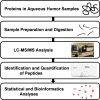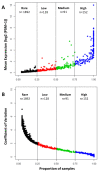The Constitutive Proteome of Human Aqueous Humor and Race Specific Alterations
- PMID: 33217969
- PMCID: PMC7709111
- DOI: 10.3390/proteomes8040034
The Constitutive Proteome of Human Aqueous Humor and Race Specific Alterations
Abstract
Aqueous humor (AH) is the fluid in the anterior and posterior chambers of the eye that contains proteins regulating ocular homeostasis. Analysis of aqueous humor proteome is challenging, mainly due to low sample volume and protein concentration. In this study, by utilizing state of the art technology, we performed Liquid-Chromatography Mass spectrometry (LC-MS/MS) analysis of 88 aqueous humor samples from subjects undergoing cataract surgery. A total of 2263 unique proteins were identified, which were sub-divided into four categories that were based on their detection in the number of samples: High (n = 152), Medium (n = 91), Low (n = 128), and Rare (n = 1892). A total of 243 proteins detected in at least 50% of the samples were considered as the constitutive proteome of human aqueous humor. The biological processes and pathways enriched in the AH proteins mainly include vesicle mediated transport, acute phase response signaling, LXR/RXR activation, complement system, and secretion. The enriched molecular functions are endopeptidase activity, and various binding functions, such as protein binding, lipid binding, and ion binding. Additionally, this study provides a novel insight into race specific differences in the AH proteome. A total of six proteins were upregulated, and five proteins were downregulated in African American subjects as compared to Caucasians.
Keywords: aqueous humor; mass spectrometry; proteomics.
Conflict of interest statement
The authors declare no conflict of interest.
Figures






References
Grants and funding
LinkOut - more resources
Full Text Sources
Molecular Biology Databases

